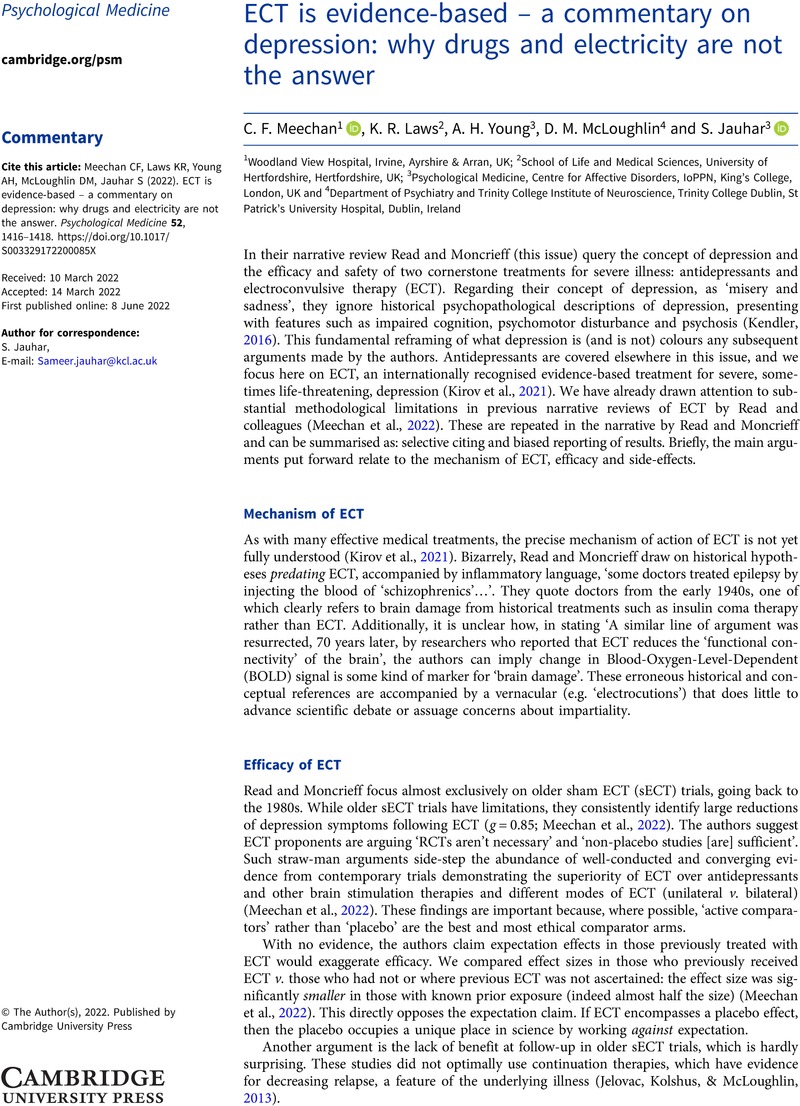No CrossRef data available.
Article contents
ECT is evidence-based – a commentary on depression: why drugs and electricity are not the answer
Published online by Cambridge University Press: 08 June 2022
Abstract
An abstract is not available for this content so a preview has been provided. Please use the Get access link above for information on how to access this content.

- Type
- Commentary
- Information
- Copyright
- Copyright © The Author(s), 2022. Published by Cambridge University Press
References
Duma, A, Maleczek, M, Panjikaran, B, Herkner, H, Karrison, T, & Nagele, P. (2019). Major Adverse Cardiac Events and Mortality Associated with Electroconvulsive Therapy. Anesthesiology, 130(1), 83–91. http://dx.doi.org/10.1097/ALN.0000000000002488.CrossRefGoogle ScholarPubMed
Jelovac, A., Kolshus, E., & McLoughlin, D. M. (2013). Relapse following successful electroconvulsive therapy for major depression: A meta-analysis. Neuropsychopharmacology, 38(12), 2467–2474. https://doi.org/10.1038/npp.2013.149.CrossRefGoogle ScholarPubMed
Kaster, T. S., Vigod, S. N., Gomes, T., Sutradhar, R., Wijeysundera, D. N., & Blumberger, D. M. (2021). Risk of serious medical events in patients with depression treated with electroconvulsive therapy: A propensity score-matched, retrospective cohort study. The Lancet. Psychiatry, 8(8), 686–695. https://doi.org/10.1016/S2215-0366(21)00168-1.CrossRefGoogle ScholarPubMed
Kendler, K. S. (2016). The phenomenology of major depression and the representativeness and nature of DSM criteria. The American Journal of Psychiatry, 173(8), 771–780. https://doi.org/10.1176/appi.ajp.2016.15121509.CrossRefGoogle ScholarPubMed
Kirov, G., Jauhar, S., Sienaert, P., Kellner, C. H., & McLoughlin, D. M. (2021). Electroconvulsive therapy for depression: 80 years of progress. The British Journal of Psychiatry, 219(5), 594–597. http://dx.doi.org/10.1192/bjp.2021.37.CrossRefGoogle ScholarPubMed
Meechan, C. F., Laws, K. R., Young, A. H., McLoughlin, D. M., & Jauhar, S. (2022). A critique of narrative reviews of the evidence-base for ECT in depression. Epidemiology and Psychiatric Sciences, 31, e10. https://doi.org/10.1017/S2045796021000731.CrossRefGoogle ScholarPubMed
Munk-Olsen, T., Laursen, T. M., Videbech, P., Mortensen, P. B., & Rosenberg, R. (2007). All-cause mortality among recipients of electroconvulsive therapy: Register-based cohort study. The British Journal of Psychiatry: The Journal of Mental Science, 190, 435–439. https://doi.org/10.1192/bjp.bp.106.026740.CrossRefGoogle ScholarPubMed
Rönnqvist, I., Nilsson, F. K., & Nordenskjöld, A. (2021). Electroconvulsive Therapy and the Risk of Suicide in Hospitalized Patients With Major Depressive Disorder. JAMA Network Open, 4(7), e2116589. http://dx.doi.org/10.1001/jamanetworkopen.2021.16589.CrossRefGoogle ScholarPubMed
Rose, D., Fleischmann, P., Wykes, T., Leese, M., & Bindman, J. (2003). Patients’ perspectives on electroconvulsive therapy: Systematic review. BMJ, 326(7403), 1363. https://doi.org/10.1136/bmj.326.7403.1363.CrossRefGoogle ScholarPubMed
Sackeim, H A., Prudic, J., Fuller, R., Keilp, J., Lavori, P W., & Olfson, M. (2007). The Cognitive Effects of Electroconvulsive Therapy in Community Settings. Neuropsychopharmacology, 32(1), 244–254. http://dx.doi.org/10.1038/sj.npp.1301180.CrossRefGoogle ScholarPubMed
Semkovska, M., & McLoughlin, D. M. (2010). Objective cognitive performance associated with electroconvulsive therapy for depression: A systematic review and meta-analysis. Biological Psychiatry, 68(6), 568–577. https://doi.org/10.1016/j.biopsych.2010.06.009.CrossRefGoogle ScholarPubMed
Watts, B. V., Peltzman, T., & Shiner, B. (2021). Mortality after electroconvulsive therapy. The British Journal of Psychiatry, 219(5), 588–593. https://doi.org/10.1192/bjp.2021.63.CrossRefGoogle ScholarPubMed
Wells, K, Hancock, N, & Honey, A. (2021). How Do People Perceive and Adapt to Any Consequences of Electro Convulsive Therapy on Their Daily Lives?. Community Mental Health Journal. http://dx.doi.org/10.1007/s10597-021-00913-7.CrossRefGoogle ScholarPubMed





